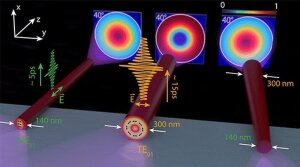Modeling semiconductor nanowire lasers
Modellierung von Halbleiter-Nanowire-Lasern
Image: Ulf PeschelModeling semiconductor nanowire lasers
Semiconductor nanowires can be grown easily and with high optical quality. As they form tiny resonators where photons are strongly coupled with the direct transition of the semiconductor material they are ideal candidates to form micro-optical circuit elements and nanolasers. As they are coherent nano-lightsources they form perfect links between electronic and photonic integrated circuits.
In our group we deal with the numerical modeling of lasing processes and of polaritonic effects in ZnO and CdS nanowires. To this end we have coupled electromagnetic modeling based on Finite Difference Time Domain (FDTD) calculations with quantum mechanical calculations (Semiconductor Maxwell-Bloch equations). Strong collaborations exist with various experimental groups in the framework of the DFG-Forschergruppe FOR1616.
- R. Buschlinger, M. Lorke, and U. Peschel, "Coupled-Mode Theory for Semiconductor Nanowires", Phys. Rev. Applied 7, 034028 (2017). DOI: 10.1103/PhysRevApplied.7.034028
- T. Michalsky, H. Franke, R. Buschlinger, U. Peschel, M. Grundmann, R. Schmidt-Grund, "Coexistence of strong and weak coupling in ZnO nanowire cavities", European Journal of Applied Physics 74, 30502 (2016) DOI: 10.1051/epjap/2016160093
- R. Buschlinger, M. Lorke, and U. Peschel, "Light-matter interaction and lasing in semiconductor nanowires: A combined finite-difference time-domain and semiconductor Bloch equation approach", Phys. Rev. B 91, 045203 (2015) DOI: 10.1103/PhysRevB.91.045203External link
- R. Röder, D. Ploss, A. Kriesch, R. Buschlinger, S. Geburt, U. Peschel, C. Ronning, "Polarization features of optically pumped CdS nanowire lasers", Journal of Physics D: Applied Physics 47 394012 (2014). DOI:10.1088/0022-3727/47/39/394012
